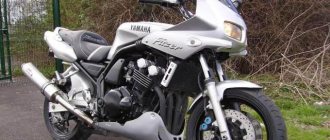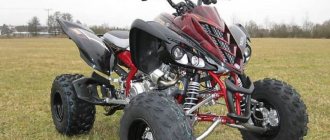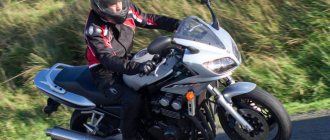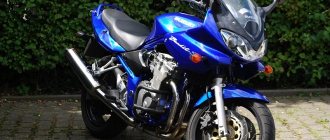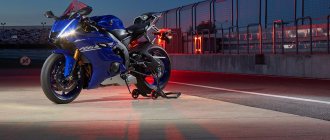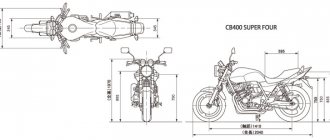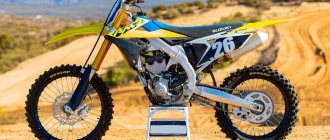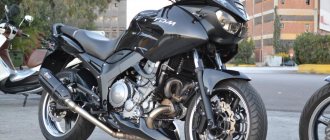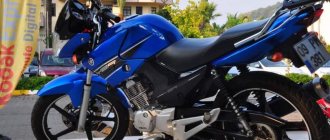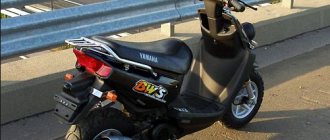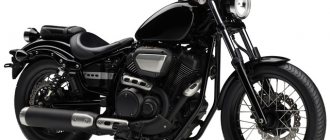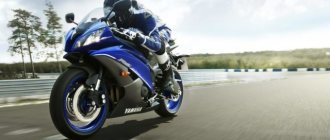This sports bike was not at all mediocre; it occupied good positions. However, he cannot be called a favorite of the public, because he never bathed in the rays of fame that descended on some of his brothers. One way or another, the Yamaha FZR 600 deserves a lot, and what it definitely cannot be denied is its contribution to the motorcycle industry.
The machine is primarily suitable for connoisseurs of retro sports bikes. For everyone else, the model may be interesting only to a certain extent. This motorcycle lacks stars from heaven, and its design can no longer surprise anyone.
Dimensions and weight
Without fuel, the FZR 600 weighs approximately 180 kg, which is quite acceptable for a sports bike. The wheelbase is 1415 mm. The tank volume here is as much as 19 liters, which is more than enough for a representative of this class. Average consumption per hundred kilometers is about 6 liters, which is quite a bit for a sports car.
Key technologies used in FZR600:
The Genesis concept - based on the use of a Deltabox frame and a forward tilt of the cylinders - allowed the fuel tank to be moved slightly lower, further reducing the motorcycle's center of gravity.
EXUP technology, actively used by Yamaha in sports motorcycles and based on the use of a mechanical damper in the exhaust system that opens depending on engine speed, has made it possible not only to increase torque in the mid-speed zone, but also to compensate for power losses in models for some countries with high environmental requirements.
In 1995, based on the Yamaha FZR600, the Yamaha YZF600R Thundercat model appeared, which at that time represented the latest generation of the FZR600. And only in 1996 the Thundercat received a restyling and finally lost the features of the FZR600, which in parallel continued to be produced until 1999 inclusive.
Chassis and brakes
The rear suspension has only 115mm of travel, but the 41mm front fork has 130mm of travel. This is quite enough to ensure maneuverability and comfortable handling. Of course, all this is relevant only on a flat road, which should not be forgotten.
Brakes at the rear are a two-piston caliper and disc, while at the front there are a pair of discs along with four-piston calipers. This is a common solution for sports motorcycles. The frame here is also typical and is a steel Deltabox.
Review of the Yamaha FZR 600 Genesis motorcycle
Personally, I was prompted to purchase by the price-quality ratio. Let me see the smart guy who will offer something cooler for 130,000 wooden ones! Believe me, an old wolf, for that amount of money you will not get such sporting qualities from any other device. There are no thoughts about selling yet, although anything is possible. In short, if you find an option in good condition, don’t even think about thinking!
Here are the main advantages of the Yamaha Phaser 600:
- the engine is not boring; — The suspension is stiff, but it allows you to feel the road and move to the fullest.
The main drawback is that it’s not a very comfortable ride with a girl behind.
PS I would be incredibly grateful to those who can help me find clip-ons for this particular motorcycle.
And once again, no matter what the reviews of various “underachievers” write about the Yamaha FZR 600, believe me - the engine is excellent.
And remember its price!!! Otherwise we compare them with devices that cost half a lemon of rubles and turn our noses up. The model is not bad, of course, but my friend had a lot of problems with it. The box did not connect well, some kind of fuel element was changed twice, but he had it in the early 90s, so maybe it depends on that.
When choosing a specific motorcycle model, for some reason I immediately settled on it. And they threw a lot of mud at it - sometimes they talked about the enormous oil consumption, sometimes they relied on the unreliability of the mechanisms, sometimes about the harshness of the ride. I learned about everything while reading reviews about the phaser 600. Fortunately, I came across a device in excellent condition, which dispelled all doubts. Many so-called “experts” still consider Yamaha to be the worst of the Japanese motorcycles. Don't be fooled!
To tell the truth, the FZR is really stiff - over a few hours of driving it really takes its toll.
You feel particular discomfort when there is a passenger behind you. It constantly hangs over the driver, pushes him when braking, and during acceleration runs the risk of completely tearing the carrier off the horse. In a word, it's a race to the bottom.
The engine is simply fiery! It shows its qualities especially clearly at the top end - my wife even cried with fear for the first time, but then she got used to it, trusted me and the phaser 600. But the model let us down a little at the bottom end - the lack of EXUP makes itself felt. I'm no more than a hundred meters from the nearest highway, but even this short stretch on a dirt road is unbearable! Even with my 10 years of driving experience, sometimes I stall.
The phaser returns to its normal state after 4000 revolutions, and after 6-7 thousand, it is already in flight mode! If you risk seating a passenger weighing more than 60 kg, the engine will not like it very much. But in general, the engine is what you need, if you study it thoroughly and get used to it. At first it’s a little scary from the tractor roar of the gearbox, but then you get used to it as it should.
The clutch of the Yamaha FZR 600 is absolutely out of this world - it’s impossible to predict its habits, and you want to protect your groin with a hockey shell! But if you acquire minimal skills, you will catch the neutral with a bang. Don’t even think about cranking the engine using the clutch – trouble will inevitably happen!
The device is very reliable, even more than I expected. Since I received it with a mileage of 40 thousand in 4 years, the condition was almost perfect. Only the right fork seal leaked. Among the little things - the rubber bands on the unit began to sweat due to a weak bearing, which is behind the drive sprocket. But if you don't tighten the chain, you won't notice it.
For six thousand mileage it takes about 180 g of oil. Too much? But this is the specificity of Yamaha engines, due to which they have a long service life. If I were the designers, I would add more reliability to the rear shock absorber - the tires need to be changed after 3000 km. And this is in normal driving mode, without reckless driving! The Yamaha FZR 600 is especially good in city mode, however, the low speed will not allow it to be put on turns. On the highway you need to be on guard for oncoming traffic - you might get blown away.
Night optics allows you to see everything you need, and most importantly, on time. Keep in mind that if you weigh less than 70 kg, it will not be entirely easy for you to cope with such mozza. If you are not cheapskates and do not buy Chinese consumables, then there will be no problems. For example, Chinese pads will last no more than 900 km. The Phaser 600 is quite voracious - from 10 to 12 liters it will ask for anything.
Brief history of the model
1989 - Start of production of Yamaha FZR600. Model: Yamaha FZR600 Genesis (Europe, North America). Factory designation: 3HE1, 3HE2, 3HF1, 3HH2, 3RG1, 3RH1; FZR600W, FZR600WC.
1990 - no significant changes. Model: Yamaha FZR600 Genesis (Europe, North America, Oceania). Factory designation: 3HE3, 3HE4, 3HF2, 3HG2, 3HH5, 3RG2, 3RH2; FZR600RA, FZR600RAC.
1991 - the model receives a restyling. The double headlight is replaced with a single one, the 2-piston front calipers are replaced with 4-piston ones, and the width of the rear wheel increases. Model: Yamaha FZR600 Genesis (Europe, North America). Factory designation: 3HE5, 3HE6, 3HE7, 3HF3, 3HH7, 3RG3, 3RH3; FZR600RB, FZR600RBC.
1992 - no significant changes. Model: Yamaha FZR600 Genesis (Europe, North America). Factory designation: 3HE8, 3HE9, 3HEA, 3HEB, 3HF4, 3HH9, 3RG4, 3RH4; FZR600RD, FZR600RDC.
1993 - restyling of the model. The single headlight is replaced with a double one (“fox eyes”), overall dimensions and ergonomics change, the fuel tank capacity increases from 18 to 19 liters, a new rear suspension and new wheels. The model receives a new engine with a shorter stroke (maximum power increases from 91 to 100 hp) and new carburetors (Keihin CVKD34 instead of Mikuni BDST32). Model: Yamaha FZR600 Genesis (Europe, Oceania, North America). Factory designation: 3HEC, 3HED, 3HEE, 3HEF, 3HF5, 3HG5, 3HHB, 3RG5, 3RH5; FZR600RE, FZR600REC.
1994 - no significant changes. Model: Yamaha FZR600 Genesis (Europe, North America). Factory designation: 3HHD, 4JH1, 4JH2, 4JH3, 4MH1, 4MM1; FZR600RF, FZR600RFC.
1995 - the model receives full suspension adjustment. This version was also sold as the Yamaha YZF600R Thundercat from 1995 to 1996. Last year of production for Europe. Model: Yamaha FZR600 Genesis (Europe, North America). Factory designation: 3HHF, 4JH4, 4JH5, 4JH6, 4MH2, 4MM2; FZR600RG, FZR600RGC.
1996 - no significant changes. Model: Yamaha FZR600 Genesis (North America). Factory designation: FZR600RH, FZR600RHC.
1997 - no significant changes. Model: Yamaha FZR600 Genesis (North America). Factory designation: FZR600RJ, FZR600RJC.
1998 - no significant changes. Model: Yamaha FZR600 Genesis (North America). Factory designation: FZR600RK, FZR600RKC.
1999 is the last year of production. Model: Yamaha FZR600 Genesis (North America). Factory designation: FZR600RL, FZR600RLC.
Specifications:
| Model | Yamaha FZR600 Genesis |
| Motorcycle type | sport |
| Year of issue | 1989-1999 |
| Frame | steel Deltabox |
| engine's type | 4-cylinder, 4-stroke, in-line |
| Working volume | 599 cm³ |
| Bore/Stroke | 59.0 x 54.8 mm – FZR600 (1989-1992) 62.0 x 49.6 mm – FZR600 (1993-1999) |
| Compression ratio | 12,0:1 |
| Cooling | liquid |
| Number of valves per cylinder | DOHC, 4 valves per cylinder |
| Fuel supply system | Carburetor, 4x Mikuni BDST32 – FZR600 (1989-1992) Carburetor, 4x Keihin CVKD34 – FZR600 (1993-1999) |
| Ignition type | TCI (digital) |
| Maximum power | 91.0 hp (67.0 kW) at 10500 rpm – max. power for FZR600 (1989-1992) 100.0 hp (73.5 kW) at 11500 rpm – max. power for FZR600 (1993-1999) |
| Maximum torque | 66.0 Nm (6.7 kg*m) at 8500 rpm – max. torque for FZR600 (1989-1992) 66.0 Nm (6.7 kg*m) at 9500 rpm – max. moment for FZR600 (1993-1999) |
| Transmission | 6-speed |
| type of drive | chain |
| Front tire size | 110/70V17-V240 – FZR600 (1989-1990) 110/70VR17-V240 – FZR600 (1991-1992) 120/60ZR17 – FZR600 (1993-1999) |
| Rear tire size | 130/70V18-V240 – FZR600 (1989-1990) 140/60VR18-V240 – FZR600 (1991-1992) 160/60 ZR17 – FZR600 (1993-1999) |
| Front brakes | 2 discs, 298 mm, 2-piston calipers – FZR600 (1989-1990) 2 discs, 298 mm, 4-piston calipers – FZR600 (1991-1999) |
| Rear brakes | 1 disc 245 mm, 2-piston caliper |
| Front suspension | 41 mm telescopic fork, 130 mm travel – FZR600 (1989-1994) 41 mm telescopic fork (all adjustments), 130 mm travel – FZR600 (1995-1999) |
| Rear suspension | pendulum with monoshock absorber, stroke 115 mm – FZR600 (1989-1992) pendulum with monoshock absorber, stroke 120 mm – FZR600 (1993-1994) pendulum with monoshock absorber (all adjustments), stroke 120 mm – FZR600 (1995-1999) |
| Length | 2095 mm – FZR600 (1989-1992) 2145 mm – FZR600 (1993-1999) |
| Width | 700 mm – FZR600 (1989-1992) 725 mm – FZR600 (1993-1999) |
| Height | 1160 mm – FZR600 (1989-1990) 1155 mm – FZR600 (1991-1992) 1180 mm – FZR600 (1993-1999) |
| Wheelbase | 1420 mm – FZR600 (1989-1990) 1425 mm – FZR600 (1991-1992) 1415 mm – FZR600 (1993-1999) |
| Minimum ground clearance (clearance) | 135 mm |
| Seat height | 785 mm – FZR600 (1989-1992) 795 mm – FZR600 (1993-1999) |
| Acceleration to 100 km/h | 3.6 sec |
| Maximum speed | 240 km/h |
| Gas tank capacity | 18.0 l (including reserve - 3.4 l) - FZR600 (1989-1992) 19.0 l (including reserve - 3.5 l) - FZR600 (1993-1999) |
| Motorcycle weight (curb) | 199 kg – FZR600 (1989-1990) 204 kg – FZR600 California (1989-1990) 201 kg – FZR600 (1991-1992) 206 kg – FZR600 California (1991-1992) 206 kg – FZR600 (1993-1999) |
